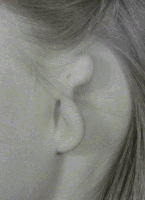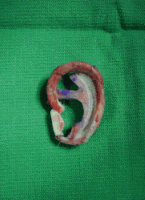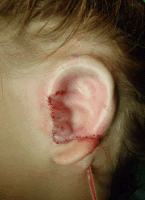

 |

|
|
 |
 |
 |
The first stage ear reconstruction, in a child with hemifacial microsomia is shown above. Cartilage is taken from the child's rib (parents cannot donate their rib cartilage) and this cartilage is carved and assembled to match the opposite ear. It is then inserted under the skin. Two additional stages are required to complete the reconstruction; both performed as outpatient procedures. Before undergoing ear reconstruction, it is wise to ask your doctor to see examples of his or her work. It is very difficult to rebuild an ear that did not turn out well the first time. For more detailed information on ear reconstruction, see the Microtia section.
It is also possible for children to undergo reconstruction (by a specialized ENT) of the absent eardrum in order to try to improve hearing on the affected side, and achieve some stereo hearing that improves the localization of sound. The decision as to whether or not to proceed with inner ear reconstruction should be made with a specialist in this area.
Early
Non-Surgical Treatment | Jaws
<<More about
Hemifacial Microsomia